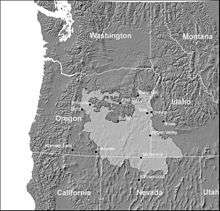Sagebrush Cooperative
The Sagebrush Cooperative is collaborative group based in southeastern Oregon and adjacent portions of Idaho and Nevada involving land managers, owners, and interest groups with the goal of improved management and conservation of shrub steppe systems.

Why protect sagebrush?
The sagebrush steppe ecosystem, an icon of the western United States, is being recognized by many to be threatened or degraded across much of its range.[1] Habitat for sagebrush steppe dependent species is being eliminated by energy development, altered fire regimes and rapid conversion to exotic annual grasslands and juniper woodlands.[1][2] In recent years, the sagebrush steppe has received increasing attention and there is a need for regional coordination and assessment of the opportunities for partnerships and projects to better manage, conserve and restore key habitats. One of the largest remaining blocks of high quality sagebrush steppe is in the High Desert, a portion of several ecoregions spanning southeastern Oregon, northern Nevada and southwestern Idaho (Figure 1). This area includes the higher elevation portions of the Columbia Plateau and northern Great Basin from just south of the Blue Mountains to the Sheldon National Wildlife Refuge and the Owyhee Uplands.
Despite the fact that the sagebrush steppe ecosystem is being increasingly recognized as important and threatened, there is remarkably little published data or references documenting current condition, trends, threats, or the effectiveness of recent management activities in sagebrush steppe for the region. Recent range-wide analyses spurred by the petitions to list the greater sage-grouse as an endangered species have documented broad trends across the west[1] but do not include data or information at a scale useful for local prioritization and project planning.
Sagebrush steppe habitats emerged as priority habitats in the Oregon,[3] Idaho,[4] and Nevada[5] state wildlife agency strategies (State Wildlife Plans) The Oregon Conservation Strategy identifies sagebrush steppe and shrublands as a Strategy Habitat and multiple sagebrush steppe dependent species as Strategy Species.[3] The Idaho Comprehensive Wildlife Conservation Strategy identifies southern xeric shrubland and steppe, which includes multiple sagebrush steppe ecological systems, as a statewide Priority Habitat.[4] The Idaho Strategy also identifies many associated Species of Greatest Conservation Need.[4] The Nevada Wildlife Action Plan identifies sagebrush as a Key Habitat and eight sagebrush dependent species as Species of Conservation Priority.[5] Each of the State Wildlife Plans identifies specific priority geographic areas for conservation of sagebrush steppe within the High Desert region (Appendix A).[3][4][5]
What does the cooperative do?
- Works to identify strategies and priorities for successful conservation of sagebrush steppe at a regional scale.
- Shares information:
- Habitat and wildlife monitoring data;
- Best management practices;
- Monitoring methods;
- Analytical tools;
- Current scientific developments.
- Develops and distributes analytical tools.
- Identifies gaps in available information in order to direct research and funding.
- Helps find funding for projects.
- Put projects in larger context to be more effective regionally.
- Coordinates efforts of related organizations.
Members
- Bureau of Land Management
- Eastern Oregon Agricultural Research Center OSU/USDA ARS
- Natural Resources Conservation Service
- Oregon Department of Fish and Wildlife
- Oregon Habitat Joint Venture
- Oregon Sage Grouse Conservation Planning Team
- Oregon Watershed Enhancement Board
- PRBO Conservation Science
- The Nature Conservancy
- United States Fish and Wildlife Service
- United States Forest Service
- Cooperative Weed Management Areas
- Several private ranches
- Soil and Water Conservation Districts
- Watershed Councils
History
Appendix A: Wildlife Strategy Focal Areas with significant Sagebrush Steppe in the Assessment Region
Idaho Comprehensive Wildlife Conservation Strategy Focal Areas
- 510: Owyhee Mountains
- 514: Oywhee Canyonlands
- MCK-1: Bruneau Escarpment
Nevada Comprehensive Wildlife Conservation Strategy Preliminary Focal Areas
- 33: Sheldon NWR
- 34: Montana Mountains
- 35: Santa Rosa Range
- 36: Owyhee Desert
Oregon Conservation Strategy Conservation Opportunity Areas
- NBR-01: Squaw Ridge area playas and sagebrush
- NBR-03: Lake Albert - Honey Creek
- NBR-05: Hart Mountain area
- NBR-06: Basque Hills - Hawk Mountain area plains
- NBR-09: Steens Mountain - Alvord Basin
- NBR-10: Malheur River area
- NBR-11: Trout Creek Mountains
- NBR-12: Saddle Butte
- NBR-13: Middle Owyhee River area
- NBR-14: Upper Owyhee
- BM-01: Deschutes River area
- BM-03: Lower John Day River area
- BM-05: Picture John Day River area
- BM-06: South Fork Crooked River area
- BM-13: Middle Fork John Day River
- BM-14: Logan Valley
- BM-15: North Fork Malheur/Monument Rock area
- BM-16: Bully Creek area
- BM-20: Burnt River
- CP-03: Lower Deschutes River
- CP-05: Lower John Day
- CP-06: Boardman area
- CP-07: Lower Umatilla
References
- Connelly, J.W., S.T. Knick, M.A. Schroeder, and S.J. Stiver. 2004. Conservation assessment of greater sage-grouse and sagebrush habitats. Western Association of Fish and Wildlife Agencies. Unpublished Report. Cheyenne Wyoming.
- Brooks, M.L., and D.A. Pyke. 2002. Invasive plants and fire in the deserts of North America. Pages 1–14 in Galley KEM, Wilson TP, eds. Proceedings of the Invasive Plant Workshop: The Role of Fire in the Control and Spread of Invasive Species. Tallahassee (FL): Tall Timbers Research Station.
- Oregon Department of Fish and Wildlife. 2006. Oregon Conservation Strategy. Oregon Department of Fish and Wildlife, Salem, Oregon. http://www.dfw.state.or.us/conservationstrategy/contents.asp
- Idaho Department of Fish and Game. 2005. Idaho Comprehensive Wildlife Conservation Strategy. Idaho Conservation Data Center, Idaho Department of Fish and Game, Boise, ID. http://fishandgame.idaho.gov/cms/tech/CDC/cwcs/cfm pg 73-74.
- Wildlife Action Plan Team. 2006. Nevada Wildlife Action Plan. Nevada Department of Wildlife, Reno.